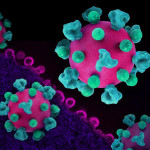 Compared with previous years, people who contract HIV today might experience a more rapid decline in CD4 counts, according to a new study presented Tuesday, March 1, at the 18th Conference on Retroviruses and Opportunistic Infections (CROI) in Boston. If confirmed in other studies, the results could ultimately influence decisions about when to start antiretroviral (ARV) therapy.
Compared with previous years, people who contract HIV today might experience a more rapid decline in CD4 counts, according to a new study presented Tuesday, March 1, at the 18th Conference on Retroviruses and Opportunistic Infections (CROI) in Boston. If confirmed in other studies, the results could ultimately influence decisions about when to start antiretroviral (ARV) therapy.
In 2009, Luuk Gras, MSc, from the Stichting HIV Monitoring in Amsterdam, and his colleagues published a paper documenting the fact that people enrolled in the ATHENA HIV cohort had different viral load and CD4 set points in recent years compared with previous time periods.
In most people, there is a profound burst of viral replication in the weeks after becoming infected, which is tied to a corresponding drop in CD4 counts. In the subsequent months, the immune system becomes better able to control HIV, so virus levels drop to a steady state and CD4s climb back toward pre-infection levels. These new levels are called the “set point,” and they are relevant to researchers because studies have found that they can influence how quickly or slowly a person’s HIV disease will progress. The higher the viral load set point, and the lower the CD4 set point, the faster the person’s progression.
Gras and his colleagues reported that in the ATHENA cohort, HIV-positive men appeared to be recovering less well after initial HIV infection than men in previous years—their viral set points were higher and their CD4 set points were lower. Following this observation, Gras’s team wondered whether actual disease progression patterns had also changed. These data were presented at CROI.
Gras and his colleagues selected 607 HIV-positive men who have sex with men from ATHENA who had documentation of recent infection and who also had CD4 counts measured between 9 and 27 months after the estimated seroconversion date and before starting antiretroviral (ARV) therapy. Of the 607 men, 111 were infected between 1984 and 1995, 139 between 1996 and 2002, and 357 between 2003 and 2007.
Estimating the slope of CD4 declines is challenging. For one thing, the slopes can be interrupted for reason that can include starting ARV treatment, developing an AIDS-defining infection or dying. This is called the “drop out” effect. To overcome these challenges, Gras’s team created three models. In one, researchers did not account for the random nature of the dropouts, whereas in the other two (called selection models and pattern-mixture models) they did, which makes the latter two models possibly more accurate.
Gras and his colleagues reported at CROI that the two latter models documented a significant change the CD4 decline over time. First, the CD4 set point at 9 to 27 months after seroconversion diminished over time. It was 580 for those who seroconverted between 1984 and 1995. It dropped to 550 for those who seroconverted between 1996 and 2002 and then to 490 for those between 2003 and 2007.
What’s more the slope of the decline steepened as time passed. In the pattern-mixture and selection models, CD4s declined almost 50 percent faster in those who seroconverted between 2003 and 2007 compared with those who seroconverted between 1984 and 1995.
While Gras and his coauthors did not put forth an explanation for their findings, they did offer one potential hypothesis in their earlier study. They speculated that, compared with earlier years, the source of recent infections is more likely to be people in the acute phase of infection, when virus levels are often in the millions of copies. If viral and CD4 set points are contingent on the virus levels of the person from whom HIV is acquired, this could influence the set points and the subsequent speed of disease progression.
The authors conclude by stating: “These results may have implications for planning on when to start [ARV therapy].”
Advertisement
Advertisement
Advertisement






Comments
Comments